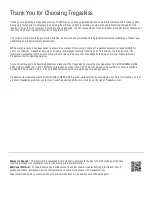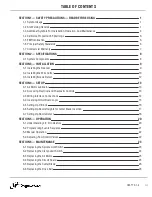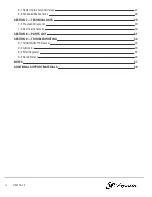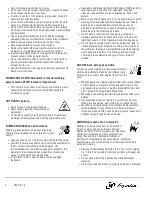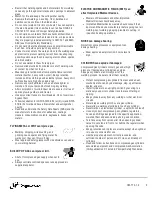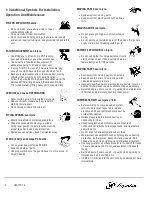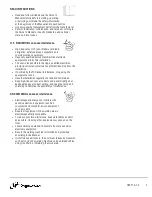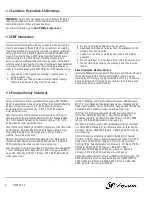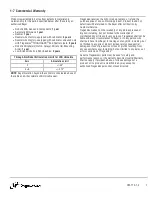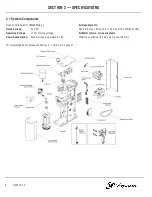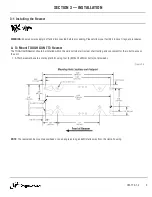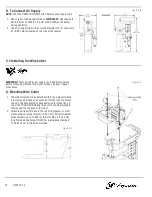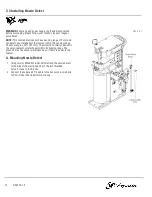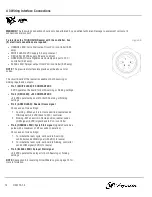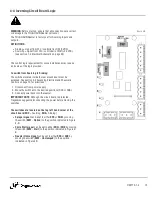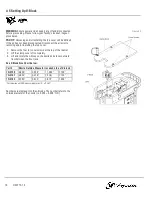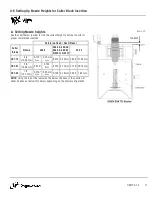
l
Turn off all equipment when not in use.
l
Do not use worn, damaged, undersized, or repaired cables.
l
Do not drape cables over your body.
l
If earth grounding of the workpiece is required, ground it
directly with a separate cable.
l
Do not touch electrode if you are in contact with the work,
ground, or another electrode from a different machine.
l
Do not touch electrode holders connected to two welding
machines at the same time since double open-circuit voltage
will be present.
l
Use only well-maintained equipment. Repair or replace
damaged parts at once. Maintain unit according to Manual.
l
Wear a safety harness if working above floor level.
l
Keep all panels and covers securely in place.
l
Clamp work cable with good metal-to-metal contact to
workpiece or worktable as near the weld as practical.
l
Insulate work clamp when not connected to workpiece to
prevent contact with any metal object.
l
Do not connect more than one electrode or work cable to
any single weld output terminal. Disconnect cable for
process not in use.
l
Use GFCI protection when operating auxiliary equipment in
damp or wet locations.
SIGNIFICANT DC VOLTAGE exists in inverter welding
power sources AFTER removal of input power.
l
Turn off unit, disconnect input power, and discharge input
capacitors according to instructions in Manual before
touching any parts.
HOT PARTS can burn.
l
Do not touch hot parts bare handed.
l
Allow cooling period before working on
equipment.
l
To handle hot parts, use proper tools and/or wear heavy,
insulated welding gloves and clothing to prevent burns.
FUMES AND GASES can be hazardous.
Welding produces fumes and gases. Breathing
these fumes and gases can be hazardous to your
health.
l
Keep your head out of the fumes. Do not breathe the fumes.
l
Ventilate the work area and/or use local forced ventilation at
the arc to remove welding fumes and gases. The
recommended way to determine adequate ventilation is to
sample for the composition and quantity of fumes and
gases to which personnel are exposed.
l
If ventilation is poor, wear an approved air-supplied
respirator.
l
Read and understand the Safety Data Sheets (SDSs) and the
manufacturer's instructions for adhesives, coatings,
cleaners, consumables, coolants, degreasers, fluxes, and
metals.
l
Work in a confined space only if it is well ventilated, or while
wearing an air-supplied respirator. Always have a trained
watch-person nearby. Welding fumes and gases can
displace air and lower the oxygen level causing injury or
death. Be sure the breathing air is safe.
l
Do not weld in locations near degreasing, cleaning, or
spraying operations. The heat and the rays of the arc can
react with vapors to form highly toxic and irritating gases.
l
Do not weld on coated metals, such as galvanized, lead, or
cadmium plated steel, unless the coating is removed from
the weld area, the area is well ventilated, and while wearing
an air-supplied respirator. The coatings and any metals
containing these elements can give off toxic fumes if
welded.
ARC RAYS can burn eyes and skin.
Arc rays from the welding process produce intense
visible and invisible (ultraviolet and infrared) rays
that can burn eyes and skin. Sparks fly off from the
weld.
l
Wear an approved welding helmet fitted with a proper shade
of filter lenses to protect your face and eyes from arc rays
and sparks when welding or watching (see ANSI Z49.1 and
Z87.1 listed in Principal Safety Standards).
l
Wear approved safety glasses with side shields under your
helmet.
l
Use protective screens or barriers to protect others from
flash, glare and sparks; warn others not to watch the arc.
l
Wear body protection made from durable, flame-resistant
material (leather, heavy cotton, wool). Body protection
includes oil-free clothing such as leather gloves, heavy shirt,
cuffless trousers, high shoes, and a cap.
WELDING can cause fire or explosion.
Welding on closed containers, such as tanks,
drums, or pipes, can cause them to blow up.
Sparks can fly off from the welding arc. The flying
sparks, hot workpiece, and hot equipment can
cause fires and burns. Accidental contact of
electrode to metal objects can cause sparks, explosion,
overheating, or fire. Check and be sure the area is safe before
doing any welding.
l
Remove all flammables within 35 ft (10.7 m) of the welding
arc. If this is not possible, tightly cover them with approved
covers.
l
Do not weld where flying sparks can strike flammable
material.
l
Protect yourself and others from flying sparks and hot metal.
2
OM-TT3-1.4


